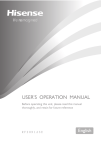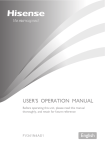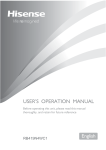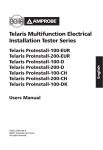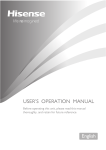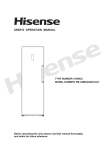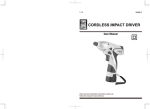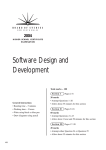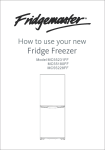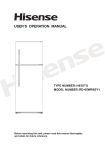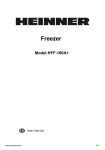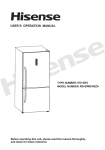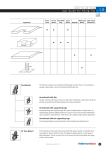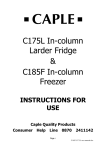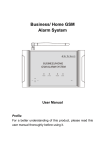Download User Guide
Transcript
RF20N6ASE 2 Contents Brief introduction…………….........………….2 Important safety instructions…..........………2 Installing your new appliance……….............5 Description of the appliance……..........…….7 Display controls…………………............…...8 Using your appliance….....…....……………10 Helpful hints and tips……...……….............12 Cleaning and care………………….............13 Troubleshooting………………………..........14 Disposal of the appliance………….....…....15 Brief introduction Thank you for your choosing Hisense products. We are sure you will find the new appliance a pleasure to use. Before you start using the appliance, we recommend that you read through this User Manual carefully, which provides description of the refrigerator functions and its usage in more details. ● Please ensure that all people who are using this appliance are familiar with its operations and safety features recommended in this User Manual. It is important that you install the appliance correctly and follow the safety instructions. ● We recommend that you keep this user's manual with the appliance for future reference and retain it for future users. ● This appliance is intended to be used in household and similar applications such as: -Kitchen area in shops, offices and other working environments; -Farmhouses, hotels, motels and Bed and breakfast and other residential types of environment; -Catering and similar non-retail applications. ● If you feel that the appliance is not operating correctly, please refer to the troubleshooting page for most common problem. If still in doubt contact the customer service help line for assistance or to arrange a call out by an authorized service engineer. Important safety instructions General safety and daily use It is important to use your appliance safely. We recommend that you follow the guidelines below. ● We recommend that you wait for 4 hours before connecting the appliance to main plug to allow the refrigerant to flow back into the compressor. It is also recommend that you let the fridge run for 3 hours before storing any food inside. ● The packaging material is recyclable, and marked with the recycling symbol . Adhere to current local regulations when disposing of packaging material. ● Do not use sharp-edge object or metal instrument to remove the frost and ice, or any frozen items from the freezer. This might damage the tubing of the refrigerant circuit and create leakage and risk of fire. ●Don't try to repair the appliance yourself. It 3 is dangerous to alter the specifications or modify this product in any way. Any damage to the power cord may cause short circuit, fire or electric shock. ● Store any food in accordance with the storage instructions from the manufacturer. ● Don't place a large amount of food directly against the air outlet on the rear wall of both the refrigerator and freezer compartment, as it obstructs air circulation. ● Don't place hot items near the plastic components of this appliance. ● Frozen food must not be refrozen once it has been thawed out. ● Don't store bottled or canned drinks (especially carbonated drinks) in the freezer compartment. Bottles and cans may explode. ● Any type of pressurised aerosol containers with the "flammable" and or small flame symbol should not be stored inside the refrigerator or freezer since it may cause an explosion. ● Don't consume ice popsicles or ice cubes straight from the freezer as this can cause frost burn to the mouth and lips. ● To avoid items falling and causing injury or damage to the appliance, don’t overload the door racks or store a large amount of food in the crisper drawers. ● Do not touch frozen items when your hands are wet. Your hands could freeze to the items and cause the frost burn. ● Don’t use mechanical devices or other means to accelerate the defrosting process, unless they are approved by the manufacturer. ● If the supply cord is damaged, it must be replaced by the manufacturer, its service agent or similarly qualified persons in order to avoid a hazard. ●When disposing of the appliance, do so only at an authorized waste disposal center. Don’t expose to flame. Safety for children and infirm persons This appliance can be used by children aged from 8 years and above and persons with educed physical, sensory or mental capabilities or lack of experience and knowledge if they have been given supervision or instruction concerning use of the appliance in a safe way and understand the hazards involved. Children shall not play with the appliance. Cleaning and user maintenance shall not be made by children without supervision. ● Keep all packaging away from children to avoid risk of suffocation. ● Protect children from being scalded by touching the very hot compressor at the rear bottom of appliance. ● Don't place items on top of the appliance as this could cause injury should they fall off. ● Never allow children to play with the appliance by hanging or standing over or on the doors, racks, shelves and drawers etc. Safety about electricity To avoid the risks that are always present when using an electric appliance, we recommend that you pay attention to the instructions about electricity below. ● We recommend after you unpack the appliance and check through the appliance. Should any damage be evident, don't plug in the appliance but contact the shop immediately from which you purchased it. Keep all packing materials in this case. ● The appliance must be applied with single phase alternating current of 115V/60Hz. ● The mains plug must be accessible when the appliance is installed. ●Make sure that the appliance is grounded properly. If still in doubt, call a qualified registered electrician. ● If the fitted plug is not suitable for your socket outlets, it should be cut off and carefully disposed of. To avoid a possible 4 shock hazard, do not insert the discarded plug into a socket. If in doubt contact a qualified, registered electrician. ● Do not use extension cords or multiple sockets which could cause overloading of wiring circuits and could cause a fire. ● Always plug your appliance into its own individual electrical socket which has a voltage rating that matched the rating plate. ●Make sure that the plug is not squashed or damaged. Otherwise, it may cause short circuit, electric shock or overheat and even cause a fire. ● Don’t insert the mains plug if the socket is loose, there is a risk of electric shock or fire. ● Switch off the appliance and disconnect it from the mains power before you clean or move it. ● Never unplug the appliance by pulling on the electrical cord. Always grip the plug firmly and pull straight out from the socket to prevent damaging the power cord. ● Don’t use the appliance without the light cover of interior lighting. ● Any electrical component must be replaced or repaired by a qualified electrician or authorized service engineer. Only genuine spares should be used. ●Don’t use electrical appliances (such as ice cream makers) inside the food storage compartments of the appliance, unless they are approved by the manufacturer. ● If the LED light uncovered, do not look direct into with an optical instruments to avoid eye injuries. If it is not functioning correctly, consult aqualified, registered electrician . The refrigerant and risk of fire The appliance contains a small quantity of refrigerant (R600a) in the refrigerant circuit. ● The iso-butane (R600a) refrigerant, is environmentally friendly but flammable, ensure that tubing of the refrigerant circuit is not damaged during transportation and installation to avoid risk of fire caused by leaking refrigerant. Caution! Keep away burning candles, lamps and other items with naked flames and sources of ignition from the appliance and ventilate the room thoroughly to avoid the risk of fire and eye injury in the case of any leakage of refrigerant (R600a). ● Do not store products which contain flammable propellants (e.g. spray cans) or explosive substances in the appliance. 6 Adjusting the door handle Ventilation of appliance Before you use the appliance, please check the refrigerator handles. If the handles are loose, please adjust them by using an Allen wrench in the clockwise direction until handles are securely in place. Each one of the handles is fitted with 2 screws. In order to improve efficiency of the cooling system and save energy, it is necessary to maintain proper ventilation around the appliance for heat dissipation. For this reason, sufficient space should be provided around the refrigerator and the area should be clear of any obstruction that affects the air circulation. 6959/64″(1776mm) 2″(50mm) Adjusting the doors 3″(76mm) ● Both left and right doors are equipped with adjustable axes, which are located in the lower hinges. ● Before adjusting its doors, please ensure that the refrigerator is level. Please review the previous section on "Leveling appliance". If you find the top of the doors are uneven, insert the Allen wrench into the hinge axis, and turn it clockwise to rise the door or anticlockwise to lower the door, and insert an E Ring into the gap. E Ring 2″(50mm) 2″(50mm) Suggestion: It is advisable leaving at least 3 inch(75mm) of clearance from the back of appliance to the wall, and at least 2 inch(50mm) from top, and on both sides. When positioned in a corner area, provide a clear space at least 16 inch(406mm) on the each hinge side to allow the doors to open enough to enable the removal of drawers and shelves. As shown in the following diagram. Adjustable part 3 0 1/8″(7 6 5mm) 2 3 5/8″( 600mm) 4 4 57/64″(1140mm) 35 3/4″( 9 0 8 mm) Allen Wrench (Provided) 67 23/32″( 1720mm) 7 Description of the appliance 1 Cabinet 2121 Top cover 3 Vertical baffle guide block 41 Glass shelf 51 Upper rack 6 Lower rack 7 Fruit and vegetables crisper 8 Lower rack 9 Multifunctional room 10 Twistable ice tray (inside) 11 Serving tray 12 1 Rollers 13 2121 Adjustable bottom feet 14 Lower freezer drawer 15 1 Upper freezer drawer 16 1 Freezer LED light (inside) 17 Refrigerator door seal 18 Lower rack 19 Crisper cover 20 9 Upper rack 21 Egg tray (inside) 22 Rack cover 11 23 2121 Refrigerator LED light (inside) 24 Display board 25 1 Cold water dispenser 26 1 Handles 27 Freezer door 28 Refrigerator door Note:Due to constant improvement of our products, your refrigerator may be slightly different from the above illustration, but its functions and using methods remain the same. Note:To get the best energy efficiency of this product, please place all shelves, drawers and baskets on their original position as the illustration above. 11 The crisper, mounted on telescopic extension slides, is for storing vegetables and fruits. You can adjust the humidity inside by using the sliding block. ● The humidity control adjusts the airflow in the crisper; higher airflow results in lower humidity. Slide the humidity control to the right in order to increase humidity. ●High humidity settings are recommended for vegetables, while low humidity is suitable for preservation of fruit. ● Follow these simple instructions to remove the crisper chamber, or freezer drawer, for cleaning. Empty the crisper chamber; pull it out to fully open position. Lift the crisper from the lateral slides. Push the slides fully in to avoid damage when closing the door. Using the refrigerator chamber The refrigerator chamber is suitable for storage of vegetable and fruits. Separate packing of different foods is recommended to avoid losing moisture or flavour permeating into other foods. Caution! Never close doors while the shelves, crisper and/or telescopic slides are extended. It may damage the unit. Caution Do not allow babies or children go inside the refrigerator, as they could injure themselves or damage the refrigerator. Do not sit on the freezer door. The door may break. Do not allow children to climb into the freezer basket. If you remove the divider to clean the basket bin, you must reinstall the divider after cleaning to prevent children from getting trapped inside the basket. Twistable ice tray ● Twistable ice tray is placed in the upper freezer drawer to make and store ice cubes. 1.Pull out the twistable ice tray from the installation bracket. 2.Fill with drinking water below the maximum level mark. 3.Place the filled ice tray back to the bracket. 4.Await for around 3 hours, twist the knobs clockwise and the ice will drop into the ice box below. Using the freezer drawer Freezer drawer is suitable for storing food required to be frozen, such as meat, ice cream, etc. To remove the freezer drawer pull it out fully, tilt up the serving tray and lift it out, then open the refrigerator doors to the maximum angle and the lower freezer drawer can be taken out, as shown in the following pictures. ① Closing door ② Opening door Lower freezer drawer Serving tray 5. Ice cubes can be stored in the ice box, if you need them, you can pull out the ice box and take them out. Note: If the ice tray is used for the first time or has not been used for a long time, please clean it before using. 12 Helpful hints and tips Energy saving tips We recommend that you follow the tips below to save energy. ●Try to avoid keeping the door open for long periods in order to conserve energy. ● Ensure the appliance is away from any sources of heat (Direct sunlight, electric oven or cooker etc). ● Don't set the temperature colder than necessary. ● Don't store warm food or evaporating liquid in the appliance. ● Place the appliance in a well ventilated, humidity free, room. Please refer to Installing your new appliance chapter. ● View 1 under the “Description of the appliance” section shows the correct arrangement for the drawers, crisper and shelves, do not adjust the combination as this is designed to be the most energy efficient configuration. Hints for fresh food refrigeration ● Do not place hot food directly into the refrigerator or freezer, the internal temperature will increase resulting in the compressor having to work harder and will consume more energy. ● Do cover or wrap the food, particularly if it has a strong flavor. ● Place food properly so that air can circulate freely around it. Hints for refrigeration ● Meat (All Types) Wrap in polythene food: wrap and place on the glass shelf above the vegetable drawer. Always follow food storage times and use by dates suggested by manufacturers. ●Cooked food, cold dishes, etc.: They should be covered and may be placed on any shelf. ●Fruit and vegetables: They should be stored in the special drawer provided. ●Butter and cheese: Should be wrapped in airtight foil or plastic film wrap. ●Milk bottles: Should have a lid and be stored in the door racks. Hints for freezing ● When first starting-up or after a period out of use, let the appliance run at least 2 hours on the higher settings before putting food in the compartment. ● Prepare food in small portions to enable it to be rapidly and completely frozen and to make it possible to subsequently thaw only the quantity required. ●Wrap up the food in aluminum foil or polyethylene food wraps which are airtight. ●Do not allow fresh,unfrozen food to touch the food which is already frozen to avoid temperature rise of the latter. ● Iced products,if consumed immediately after removal from the freezer compartment, will probably cause frost burns to the skin. ● It is recommended to label and date each frozen package in order to keep track of the storage time. Hints for the storage of frozen food ● Ensure that frozen food has been stored correctly by the food retailer ● Once defrosted, food will deteriorate rapidly and should not be re-frozen. Do not exceed the storage period indicated by the food manufacturer. Switching off your appliance If the appliance needs to be switched off for an extended period, the following steps should be taken to prevent mould on the appliance. 1. Remove all food. 2. Remove the power plug from the mains socket. 3.Clean and dry the interior thoroughly. 4.Ensure that all the doors are wedged open slightly to allow air to circulate. 13 Cleaning and care For hygienic reasons the appliance (including exterior and interior accessories) should be cleaned regularly at least every two months. Caution! The appliance must not be connected to the mains during cleaning. Danger of electrical shock! Before cleaning switch the appliance off and remove the plug from the mains socket. Exterior cleaning To maintain good appearance of your appliance, you should clean it regularly. -Wipe the digital panel and display panel with a clean, soft cloth. -Spray water onto the cleaning cloth instead of spraying directly on the surface of the appliance. This helps ensure an even distribution of moisture to the surface. -Clean the doors, handles and cabinet surfaces with a mild detergent and then wipe dry with a soft cloth. Caution! -Don't use sharp objects as they are likely to scratch the surface. -Don't use Thinner, Car detergent, Clorox, ethereal oil, abrasive cleansers or organic solvent such as Benzene for cleaning. They may damage the surface of the appliance and may cause fire. Interior cleaning ● You should clean the appliance interior regularly. It will be easier to clean when food stocks are low. Wipe the inside of the fridge freezer with a weak solution of bicarbonate of soda, and then rinse with warm water using a wrung-out sponge or cloth. Wipe completely dry before replacing the shelves and baskets. Thoroughly dry all surfaces and removable parts. ● Although this appliance automatically defrosts, a layer of frost may occur on the freezer compartment's interior walls if the freezer door is opened frequently or kept open too long. If the frost is too thick, choose a time when the supply of food stocks are low and proceed as follows: 1.Remove existing food and accessories baskets, unplug the appliance from the mains power and leave the doors open. Ventilate the room thoroughly to accelerate the thawing process. 2.When defrosting is completed, clean your freezer as described above. Caution! Don't use sharp objects to remove frost from the freezer compartment. Only after the interior is completely dry should the appliance be switched back on and plugged back into the mains socket. Door seals cleaning Take care to keep door seals clean. Sticky food and drinks can cause seals to stick to the cabinet and tear when you open the door. Wash seal with a mild detergent and warm water. Rinse and dry it thoroughly after cleaning. Caution! Only after the door seals are completely dry should the appliance be powered on. Warning! The LED light must not be replaced by the user! If the LED light is damaged, contact the customer helpline for assistance. 14 Troubleshooting If you experience a problem with your appliance or are concerned that the appliance is not functioning correctly, you can carry out some easy checks before calling for service, please see below. You can carry out some easy checks according to this section before calling for service. Warning! Don't try to repair the appliance yourself. If the problem persists after you have made the checks mentioned below, contact a qualified electrician, authorized service engineer or the shop where you purchased the product. Possible cause & Solution Problem Appliance is not working correctly Check whether the power cord is plugged into the power outlet properly. Check the fuse or circuit of your power supply, replace if necessary. It is normal that the freezer is not operating during the automatic defrost cycle, or for a short period of time after the appliance is switched on to protect the compressor. Odours from the compartments The interior of the refrigerator may need to be cleaned. Some food, containers or wrapping cause odours. The sounds below are quite normal: ●Compressor running noises. ●Air movement noise from the small fan motor in the freezer compartment or other compartments. ●Gurgling sound similar to water boiling. Noise from the appliance ● Popping noise during automatic defrosting. ●Clicking noise before the compressor starts. Other unusual noises are due to the reasons below and may need you to check and take action: The cabinet is not level. The back of appliance touches the wall. Bottles or containers fallen or rolling. It is normal to frequently hear the sound of the motor, it will need to run more when in following circumstances: ● Temperature setting is set colder than necessary The motor runs continuously ● Large quantity of warm food has recently been stored within the appliance. ●The temperature outside the appliance is too high. ●Doors are kept open for a long period. ●After your installing the appliance or it has been switched off for a long time. Check that the air outlets are not blocked by food and ensure food is placed within the appliance to allow sufficient ventilation. Ensure that A layer of frost occurs in the compartment door is fully closed. To remove the frost, please refer to “cleaning and care” section. 15 Temperature inside is too warm insufficient clearance at the sides, back and top. Temperature inside is too cold Doors You may have left the doors open too long or too frequently; or the doors are kept open by some obstacle; or the appliance is located with can't be closed easily Increase the temperature by following the "Display controls" chapter. Check whether the top of the refrigerator is tilted back by 10-15mm to allow the doors to self close, or if something inside is preventing the doors from closing. The water pan (located at the rear bottom of the cabinet) may not be properly leveled, or the draining spout ( located underneath the top of Water drips on the floor the compressor depot ) may not be properly positioned to direct water into this pan, or the water spout is blocked. You may need to pull the refrigerator away from the wall to check the pan and spout. The LED light may be damaged. Refer to replace LED lights in The light is not working cleaning and care chapter. The control system has disabled the lights due to the door being kept open too long, closend a reopens the door to reactivate the lights. Check the door seal, and if it is necessary clean the rubber gasket seal Doors does not open smoothly around the edges of the door using dish soap and warm water. Dirt and grime can collect here and cause door stick to the fridge. Disposal of the appliance The refrigerator is built from reusable materials. It must be disposed of incompliance with current local waste disposal regulations. The appliance contains a small quantity of refrigerant (R600a) in the refrigerant circuit. For your safety please refer to the section of "the refrigerant and risk of fire" in this Instruction Manual before scrapping the appliance. Please cut off the power cord to make the refrigerator unusable and remove the door seal and lock. Please be cautious of the cooling system and do not damage it by puncturing the refrigerant container and/or bending the tubing, and/or scratching of the surface coating. Correct Disposal of this product This symbol on the product or in its packing indicates that this product may not be treated as household waste. Instead, it should be taken to the appropriate waste collection point for the recycling of electrical and electronic equipment. By ensuring this product is disposed of correctly, you will help prevent potential negative consequences for the environment and human health, which could otherwise be caused by the inappropriate waste handling of this product. For more detailed information about the recycling of this product, please contact your local council your household waste disposal service, or the shop where you purchased the product.















